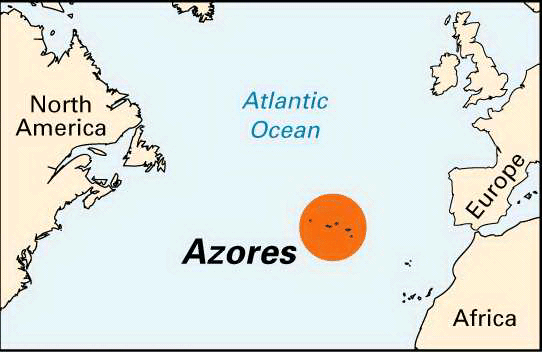Azores
THE AZORES IS AN archipelago of nine islands situated in the middle of the North ATLANTIC OCEAN, usually divided in three groups according to geographic proximity: the Eastern Group (Santa Maria and Sao Miguel), the Central Group (Terceira, Graciosa, Sao Jorge, Pico, and Faial), and the Western Group (Flores and Corvo). The Azores constitutes, along with Madeira, the only two autonomous regions of PORTUGAL, each with its own parliament and government.
These lush green islands (897 square mi or 2,322 square km, with a population of 241,763) are the peaks of an oceanic mountain chain, and their volcanic origin is associated with the clash of the American, European, and African tectonic plates. The area is subject to frequent EARTHQUAKES and has current manifestations of volcanic activity with geysers and sulfur springs. The latest eruption occurred in 1957–58 on the island of Faial. On several of these islands, volcanic cones have collapsed originating rings of landforms called caldeiras.

PORTUGUESE SETTLEMENT
It is assumed Diego de Silves was the first to explore these uninhabited islands in 1427. Their combination of fertile soil, abundant water, and mild climate contributed to a successful settlement by the Portuguese in 1443. Most of the land is hilly and covered by cropland, pastures, and forests of introduced cryptomeria conifers and acacia trees and native cedars and dogwood. Because of the proximity of the GULF STREAM, the climate is humid and temperate, with an abundance of rain throughout the year. However, weather can vary widely during the course of a single day.
Until recently, the regional economy depended on an export-oriented agriculture, subjecting the islands to alternating cycles of prosperity and decline according to external demand for their products. Main commodities have included oranges and sugarcane, with corn replacing wheat as the main cash crop at the end of the 19th century. Cattle grazing became the main agricultural activity around the 1960s, as the humid climate favors development of rich pastures. Current regional products include milk, cheese, corn, with tobacco and pineapples on the island of Sao Miguel and wine on Pico.
The average area of farms is very small (4 acres or 2 hectares), with fields divided by hedges of hydrangeas or azaleas, forming a typical patchwork, which has become a hallmark of the islands. Most of the population concentrates on small coastal towns. The seat of the government ministries and largest city is Ponta Delgada (population 44,000), on the island of Sao Miguel.
The Azores's islands have benefited from strategic importance since the 16th century, through the age of discoveries to modern times. Because of its central position between North America and Europe, the archipelago has played important role as a resupply outpost during the development of both navigation and aviation. Nevertheless, the isolation led to intense emigration to the UNITED STATES and CANADA and a consequent population decline between the 1960s and 1990s. That tendency has recently reversed thanks to rising living standards and development, made possible in part by support programs from the EUROPEAN UNION.